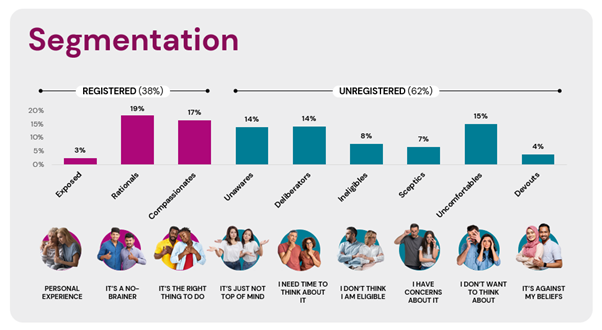Using behavioural insights and audience segmentation to increase organ donation registration in Australia
Alana Jones1, Brianna Elms1.
1Communications and Engagement, Australian Organ and Tissue Authority, Melbourne, Australia
Introduction
The Australian Organ and Tissue Authority (OTA) has 3 main objectives under the ‘Build Support’ goal of our national strategy:
Australia has an opt-in system, and registration is a key driver of consent. Around 8/10 families give consent when their loved one was registered. This drops to 4/10 when their loved one was not registered.
Like many other countries, Australia has seen a declining consent rate following the COVID19 pandemic. Registration has also flatlined since registration via driver’s licences was removed in the early 2000s. A strategic approach to reaching Australian audiences was required to deliver more effective communication.
Method
A behaviour insights research project was commissioned to:
The research was conducted in 3 phases:
Explore
Build
Unlock
Results
The research uncovered 23 drivers for registration, 33 barriers to registration, 27 motivators and 24 messages. These were used to created 9 audience personas (3 registered, 6 unregistered) that place the Australian population on a spectrum based on how likely they are to take action (see diagram).

The registered audience segments are exposed, rationals and compassionates.
The unregistered audience segments are unawares, deliberators, ineligibles, sceptics, uncomfortables and devouts.
Two main opportunities were identified through the research:
An example for opportunity 1: we split our annual awareness initiative – DonateLife Week – into 2 phases. The first phase is about engaging advocates to help spread the word about DonateLife Week.
Results included:
An example for opportunity 2: we created TikTok style video with minimal branding, a short call-to-action and sponsored it on TikTok, Reddit and Snapchat.
The results were:
Conclusion
Using an evidence-based audience segmentation of the Australian population, based on attitudes, motivations and barriers, has allowed us to deliver more tailored, strategic communication and is delivering better results against our targets.